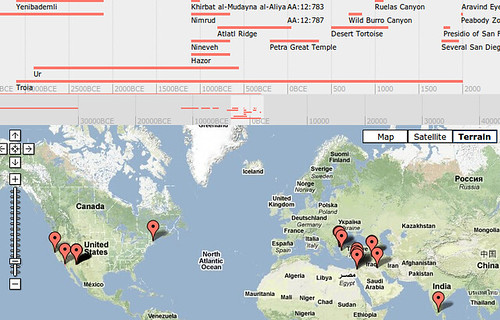The following guest blog is from Open Context’s Project Lead Eric Kansa and Editor Sarah Whitcher Kansa, who are both members of the Open Knowledge Foundation‘s Working Group on Open Data in Archaeology.
About Open Context
Open Context is a free, open access resource for the electronic publication of primary field research from archaeology and related disciplines. We developed it to help scholars and students to easily find and reuse field science data and media. The system makes data searchable and citable, with robust archival support from the California Digital Library.
The Alexandria Archive Institute, an independent 501(c)(3) non-profit organization, maintains Open Context and provides editorial oversight for Open Context content. The project has been funded by the William and Flora Hewlett Foundation, the National Endowment for the Humanities (NEH), and the Institute of Museum and Library Services (IMLS)
Key Features of Open Context:
- Data publication (with peer review, if desired) of datasets, images, maps, and related items.
- Stable URL to every project and individual item within a project. Projects, items, and groups of items can be cited elsewhere and permanently linked to print publications.
- Citation provided for every project and item.
- Project and Person information to provide the user with more in-depth knowledge about the author and background of the study.
*Faceted navigation that enables users to compose analytically precise searches and queries through a simple point and click interface. - Web services, including Atom feeds, so that content can by syndicated and visualized elsewhere on the Web.
- Creative Commons licenses so that datasets are legally free for reuse.
Open Data Publication and Archiving with Open Context
Open Context emphasizes publication to work with familiar patterns in scholarly communication and encourage data dissemination in the research community. To this end, Open Context does not disseminate raw data but instead relies on editorial supervision to add description, documentation, and structure to researcher-contributed content. This transforms raw data into a more polished and intelligible product that is still as detailed and comprehensive as the original field documentation.
In development since late 2006, Open Context now hosts over 180,000 items, including nearly 5,000 media items, from 35 archaeological sites around the world. The current rate of publication is about one project per month, and we hope to increase that rate as our publication tools become more streamlined. While Open Context contains mainly archaeological content, it can also accommodate content from other field-based sciences (public health, conservation biology, geological sciences, etc.), so please feel free to get in touch if you have data you would like to publish.
To see some of this at work, check out the recently-published Aegean Prehistory Project, featuring data on shells recovered from three archaeological sites in the Aegean. Canan Çak?rlar published these data as an online appendix to the printed publication of her Ph.D. dissertation. In addition to an overview of her project and a link to where the printed publication can be purchased, Canan also has a “person page” with information about her work, publications, etc. Her data has been drawn (via an Atom feed) into BoneCommons, a Web resource for the worldwide zooarchaeology community. Thus, Canan’s work can be found via a search engine, Open Context, BoneCommons, or any other place that draws her content from Open Context. This makes for maximum exposure of her work to her colleagues, as well as its discovery by others for uses beyond archaeomalacology.
How Open is Open Context?
Open Context requires use of Creative Commons licenses (or the CC-Zero public domain dedication). Open Context also makes all data, including structured data (in XML, JSON, and CSV formats) freely available with no login barrier.
However, Open Context does permit use of license variants that restrict commercial use. While this restriction does inhibit interoperability, some stakeholder communities, especially indigenous groups, have deep historical and political concerns regarding commercial uses of cultural heritage materials. These concerns represent complex ethical challenges, but do highlight how the ideal of “openness” needs to be evaluated by other ethical considerations.
Incentives and Guidance for Openness
The National Science Foundation recently announced additional requirements for grant-seekers to develop meaningful “Data Access” plans for their proposals. Many researchers will have little background or understanding on how best to meet this requirement. To offer guidance for the researcher community, Open Context now offers guidelines for researchers to prepare data for online publication. In addition to these, we have developed an online estimation tool, which helps scholars budget appropriately for data sharing, guide them through licensing choices, and offer tips regarding good practices in data sharing. The estimation tool then returns texts to researchers that can be used in their NSF Data Access plans.

This post is by a guest poster. If you would like to write something for the Open Knowledge Foundation blog, please see the submissions page.









3 thoughts on “Open Context”
Comments are closed.